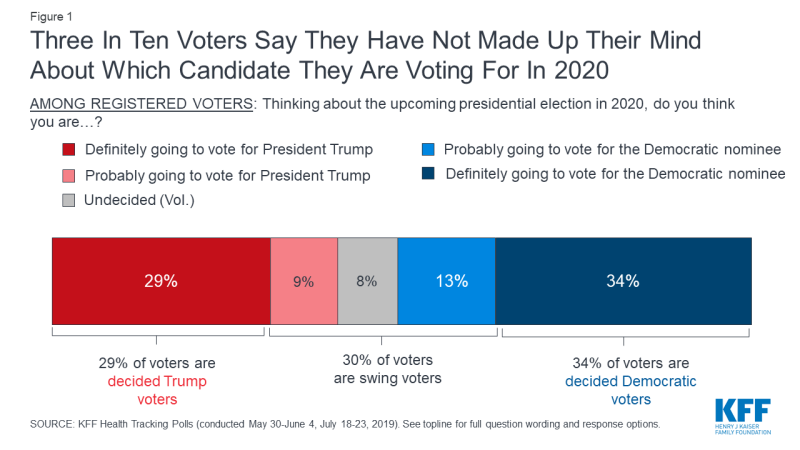Data Note: A Look At Swing Voters Leading Up To The 2020 Election
Ashley Kirzinger, Audrey Kearney, Mollyann Brodie, Charlie Cook, and Amy Walter, Henry J. Kaiser Family Foundation
Key Findings
- Three in ten voters are swing voters, meaning they haven’t made up their minds about who they plan to vote for in the 2020 presidential election. While swing voters look similar to their decided counterparts on many demographics, they tend to be younger, more moderate, and less engaged on national politics. Nearly one-fourth of swing voters say they didn’t vote in the 2018 election (22%) or in the 2016 presidential election (24%).
- It is important to note that not all “swing voters” could potentially change their vote to support the other party’s candidate. About half of swing voters (16% of all voters) are truly persuadable. These voters either say they are undecided about who they plan to vote for (8%) or say that while they are probably going to vote for either President Trump or the Democratic nominee, there is a chance they will vote for the other party’s candidate (8%). The other share of swing voters (14% of all voters) say that they are probably going to vote for either President Trump or the Democratic nominee and there is no chance they will vote for the other party’s candidate. While they say there is no chance they will vote for the other party’s candidate, they could choose to not vote at all. In other words, these folks may not change their minds to support another candidate, but if they don’t like what they see from the party they like, they could just stay home.
- Many factors could influence voters’ decisions to either vote for President Trump or the Democratic nominee or even stay home on Election Day. This analysis finds issues like climate change, health care, immigration, or the economy could influence swing voters’ vote choice in 2020. Democrats may have the edge on three issues among swing voters: climate change (38 percentage point advantage), health care (18 percentage points), and immigration (10 percentage points) while President Trump, on the other hand, may have the edge on the economy (12 percentage points). As the 2020 presidential campaign continues, this data indicates that Democrats may benefit more when the focus is on climate change, health care, and immigration, while President Trump may have the advantage on the economy among this group of swing voters. Yet, it is important to note that if the economy slows down significantly, the edge that President Trump has on the economy may dissipate.
- The issue of health care means different things to voters on different sides of the aisle. Nearly half (44%) of swing voters who prefer the Democratic nominee on health care offer responses related to increasing access to health insurance coverage as the reason why they support the Democratic nominee on this issue. Swing voters who prefer President Trump on health care do not appear to be rallying behind a single health care issue but offer varying responses. Lowering the amount people pay for health care ranks high for both sets of swing voters (19% and 16%, respectively).
-
Who Are The 2020 Swing Voters?
Nearly two-thirds of voters say they have already made up their minds about which candidate they plan to vote for. About one-third of voters (34%) say they are “definitely” going to vote for the Democratic nominee while three in ten (29%) say they are “definitely” going to vote for President Trump. This leaves three in ten voters as the crucial voting block known commonly as “swing voters.” This group of voters either say they are “probably” going to vote for President Trump (9%), “probably” going to vote for the Democratic nominee (13%), or say they are undecided about how they will vote (8%).

Figure 1: Three In Ten Voters Say They Have Not Made Up Their Mind About Which Candidate They Are Voting For In 2020
It is important to note that not all “swing voters” could potentially change their vote to support the other party’s candidate. Among voters who say they are probably going to vote for either President Trump or the Democratic nominee, few say there is “a chance” they will vote for the other party’s candidate. Among all voters, 5% say they will probably vote for President Trump but there is “a chance” they will vote for the Democratic nominee, while 3% of all voters say they will probably vote for the Democratic candidate but there is “a chance” they will vote for President Trump.
More Articles
- Jo Freeman Writes: The 2024 Libertarian National Convention as Seen Through Feminist Eyes
- Jo Freeman Writes: Kennedy vs. Trump at the Libertarian National Convention
- Board of Governors of the Federal Reserve System: Something’s Got to Give by Governor Christopher J. Waller
- February’s Hot Data Releases: Governor Christopher J. Waller, Federal Reserve Board Frames a Few of the Issues Around Inflation and the Economic Outlook
- Looking Back: Women's Congressional Policy Institute, Weekly Legislative Update; September 12-16, 2022, Screening Initiatives by Health Care and Social Service Providers
- Remarks by President Biden on American Rescue Plan Investments; September 02, 2022, South Court Auditorium Eisenhower Executive Office Building
- VA Disability: Clearer Claims Processing Guidance Needed for Selected Agent Orange Conditions, Publicly Released: Sep 01, 2022
- Ferida's Wolff's Backyard: Geese Coming Home
- Jo Freeman Reviews Russell Lee: A Photographer's Life and Legacy
- The US Housing and Mortgage Market, Risks and Resilience: Federal Reserve Governor Michelle W. Bowman






